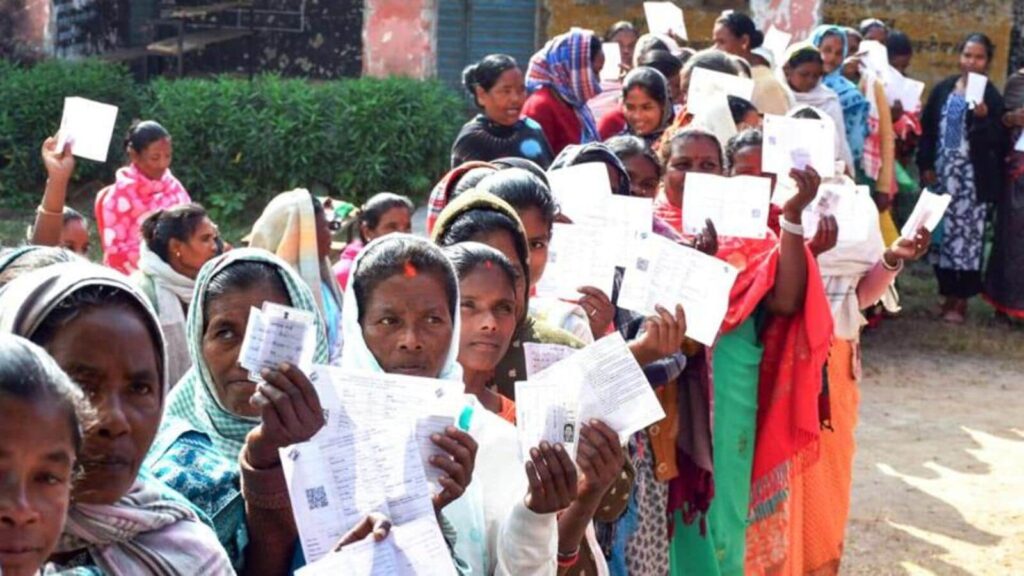Jharkhand assembly polls: Can women voters emerge as gamechanger?

The counting of votes for the Jharkhand assembly elections will take place on Saturday with political parties keeping a keen eye on the results given the higher turnout of women voters during the polls.

According to the Election Commission of India (ECI) data of electors who exercised their franchise in the assembly election 2024, women voters outnumbered their male counterparts in terms of voting percentage across 68 of the 81 assembly segments in the state.
The Jharkhand assembly elections, which had 2.6 crore registered electors, recorded a huge voter turnout of 67.74%, the highest in assembly polls since the state was created.
Interestingly, women voters outnumbered the male voters by 5,51,797 across the state, ECI officials said.
Of 81 assembly seats, women voter turnout was more than males in 68 constituencies with varying degree of leads, ranging from few hundred votes to around 25,000 votes.
Also Read: ‘Rahul Gandhi makes promises, flies abroad’: Amit Shah in poll-bound Jharkhand
Putting that into perspective, the women voter turnout was more than males in only 30 assembly segments in 2019 assembly elections. However, in total, the absolute number of total women voters across the 81 seats in 2019 was marginally lesser than male voters.
However, in 2024, with the number of seats where women turnout was higher having increased, more than double (68), as compared to 2019, the absolute number of women voters has also increased by around 5.5 lakh, around 6.4% higher than the male voters.
In 2019, on the 30 seats where the women voter turnout was more than males, 14 of these constituencies were reserved for Scheduled Tribes (ST) while three were reserved for Scheduled Castes (SC).
In terms of electoral outcome, two-third (20) of these seats, went to the four parties who are part the Indian National Developmental Inclusive Alliance (INDIA) bloc including 12 ST seats where the alliance won. On the other hand, seven went to the Bharatiya Janata Party (BJP) while three were won by others.
The substantial increase in the number of women voters in 2024 has sparked speculations about the factors behind such a sharp increase and impact it could have on the electoral result.
The Jharkhand Mukti Morcha (JMM)-led INDIA bloc attributes the increase to Mukhymantri Maiyan Samman Yojna (MMSY), which was launched by the Hemant Soren government wherein all women in age group 18-50 get ₹1,000 per month, which has been promised to be increased to ₹2,500 per month from December 2024.
According to the government, around 57 lakh women are being covered under the scheme.
“The numbers speak for themselves. The increase is unprecedented. The Maiyan Samman scheme coupled with the whirlwind campaign of our leader Kalpana Soren has made women beneficiaries come out in hordes like never before and bless our chief minister. We are set to return to power with a bigger majority with blessings from Maiyan,” said JMM spokesperson Manoj Pandey.
The opposition BJP, meanwhile, see the higher women turnout as anti-incumbency vote against ‘failed’ electoral promises of the Hemant Soren-led state government.
“They came to power promising to give ₹2,000 to all women as Chulha Kharch (Kitchen expenditure) but gave none. They started giving ₹1,000 three months before the election. Moreover, they claim 57 lakh women being covered under the scheme. But reality is only 21 lakh women have been covered till now. Also, women are also angry with this government for crimes against women. Around 7,500 rape cases were registered under this government, but chargesheets have not been filed even in half of them,” said Jharkhand BJP spokesperson Pratul Shahdeo.
Independent observers, however, remain guarded about reading much into the impact the increased female turnout could have on Saturday’s result.
“Varied factors play role in higher women turnout. The impact of Maiyan to some extent can’t be ruled out, as we have seen in other states with similar schemes. With BJP also promising a similar scheme, it served as a catalyst to bring women in centrestage. That might have led to this increase. However, Jharkhand has seen higher participation of women in the past, especially in the tribal dominated seat where the socio-cultural aspects make women being more participative. This time it has spread to other seats. However, its equally true that while women came out to vote in big numbers, in Jharkhand, which is predominantly a rural state, family and male members still dominate decision making including voting choices,” said Sudhir Pal from Election Watch.
Meanwhile, counting of votes would being at 8am on Saturday and trends of first round is expected around 9:30am, ECI officials said.
“Counting of votes will begin with postal ballots. Counting of votes in EVM will begin from 8:30am and the result of the first round is expected after 9:15am. From the second round, it takes less time, and trends are expected to be updated every half an hour thereafter,” said chief electoral officer K Ravi Kumar.
In 2019, the JMM-Congress-RJD had won a comfortable majority of 47 seats in the 81-member Jharkhand assembly. The BJP which went solo could win only 25 seats.
This time, the main electoral rivalry is between JMM-led INDIA bloc including Congress, Rashtriya Janata Dal (RJD) and Communist Party of India (Marxist–Leninist) Liberation (CPI-ML) versus BJP-led NDA which also includes All Jharkhand Students Union (AJSU) Party, Janata Dal United (JDU) and Lok Janshakti Party (Ram Vilas) LJP-R.




